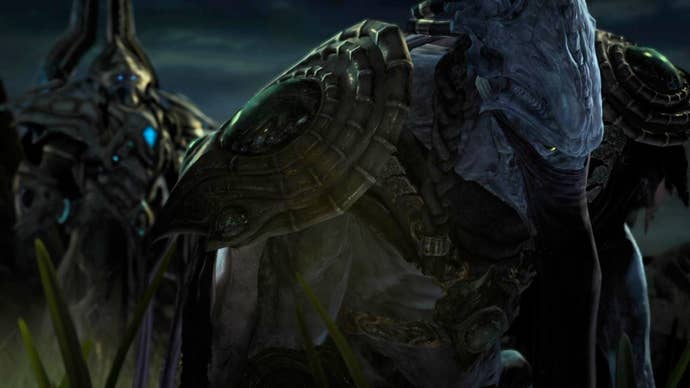Blizzard's Tim Morten on Closing StarCraft II's Curtain
Legacy of the Void's lead producer talks about the challenges of landing this very successful RTS trilogy.
This article first appeared on USgamer, a partner publication of VG247. Some content, such as this article, has been migrated to VG247 for posterity after USgamer's closure - but it has not been edited or further vetted by the VG247 team.
It seems like only yesterday that StarCraft II finally kicked off with Wings of Liberty, but in a few weeks, it'll all be over.
StarCraft II: Legacy of the Void launches on November 10, finally bringing an end to a sequel that took the form of a trilogy—an idea originally met with skepticism from fans and critics alike. At this year's TwitchCon, I caught up with Legacy of the Void's lead producer, Tim Morten, for some insight on what it takes to successfully land a project as massive as StarCraft 2.

USgamer: From a design perspective, what are the most interesting new elements of this last chapter of the StarCraft II trilogy?
Tim Morten: For the campaign, I think the biggest new element is the Spear of Adun powers—the Spear of Adun is an ancient Protoss arkship that's in orbit over the planet where you're conducting the mission. You're able to call down powers from the ship at various points during the mission, so that's a whole new mechanic for Legacy of the Void... In multiplayer, we've got Archon mode, so shared base, shared army, player versus player. And then, automated tournaments, which sort of takes some of the competitive eSports scene home. So that lets you participate in a tournament on a daily basis.
USg: How do you view the development of a trilogy like StarCraft II? Do you find that you get a second chance to make things right instead of releasing a product and moving on?
TM: It's interesting to the the industry as a whole move towards a "software as a service" model. StarCraft II, by nature of being iterative, in a similar fashion just keeps getting better and better. We see the balance evolve, we see the campaign mechanics evolve, the user interface... Every aspect of the game keeps getting better from installment to installment, from expansion to expansion. So I think Legacy of the Void represents the culmination of all of that knowledge, feedback we've gotten from players, and advancement in technology that's happened over the years... To really be the best StarCraft II that's existed so far.
USg: How vital is fan feedback, and how often does it conflict with your own ideas?
TM: Fan feedback is something we spend a lot of time trying to parse and understand general sentiment from, and it's not as easy as reading one comment, or reading the comments on one forum. Finding the trend that's behind player sentiment is something that takes a lot of breadth. For StarCraft, we see a lot of feedback on Reddit, we see a lot of feedback on the Team Liquid forums, we see a lot of feedback on the Battle.net forums... But even on a region-by-region basis, there are even more forums and places for us to get information. So we try to take that all in, and we have a dedicated community team in North America and a dedicated community team in each of the regions. We compile all that information and, as a team, on a weekly basis, we look at that, and we try to extract what we feel like the sentiment is.
Recently, we had a community summit where we brought influencers and pro players on campus at Blizzard headquarters, and we found that the Korean sentiment actually differed quite a bit from the European and North American sentiment. So we have to navigate all of that and figure out what we believe will produce the best player experience, [and] what we believe will answer what's behind the feedback we're getting.

USg: For an ongoing project like this, what are the unique challenges of working within a certain scope?
TM: First and foremost, because we're finishing out a story that's been playing out over 17 years, there's certain beats we have to make sure we tie up, resolve, and really provide satisfaction to players who finish Legacy of the Void so they don't feel like we left these big questions unanswered—they don't feel like it's a "to be continued." We don't want that sense of getting to the end and not getting the payoff that you're looking for. So, we tried to pay a lot of attention to the campaign and story, and the main characters resolving that cleanly.
And from a gameplay perspective, Protoss have appeared in the first two [installments], but this is their moment in the sun, and this is the moment, where, as a design team, we really have to think about what are the mechanics that define them as a race. And from a multiplayer perspective as well, [we think about] how we evolve the game from what was already pretty exciting in Heart of the Swarm. I think the team has really risen to those challenges, so I'm super excited to see how fans will react when they get a chance to play Legacy of the Void.
USg: Since this is your last chance with StarCraft II, are there any ideas you've been kicking around for years that you're finally getting a chance to put into the game?
TM: Definitely the co-op stands out to me as something that was always viewed as an area for great potential, but is now finally coming to life in Legacy of the Void. The one thing I would say: even if this resolves the [StarCraft 2] storyline... this is not the end of our support for StarCraft 2, and we definitely plan to continue developing content and features that will extend beyond Legacy of the Void.
